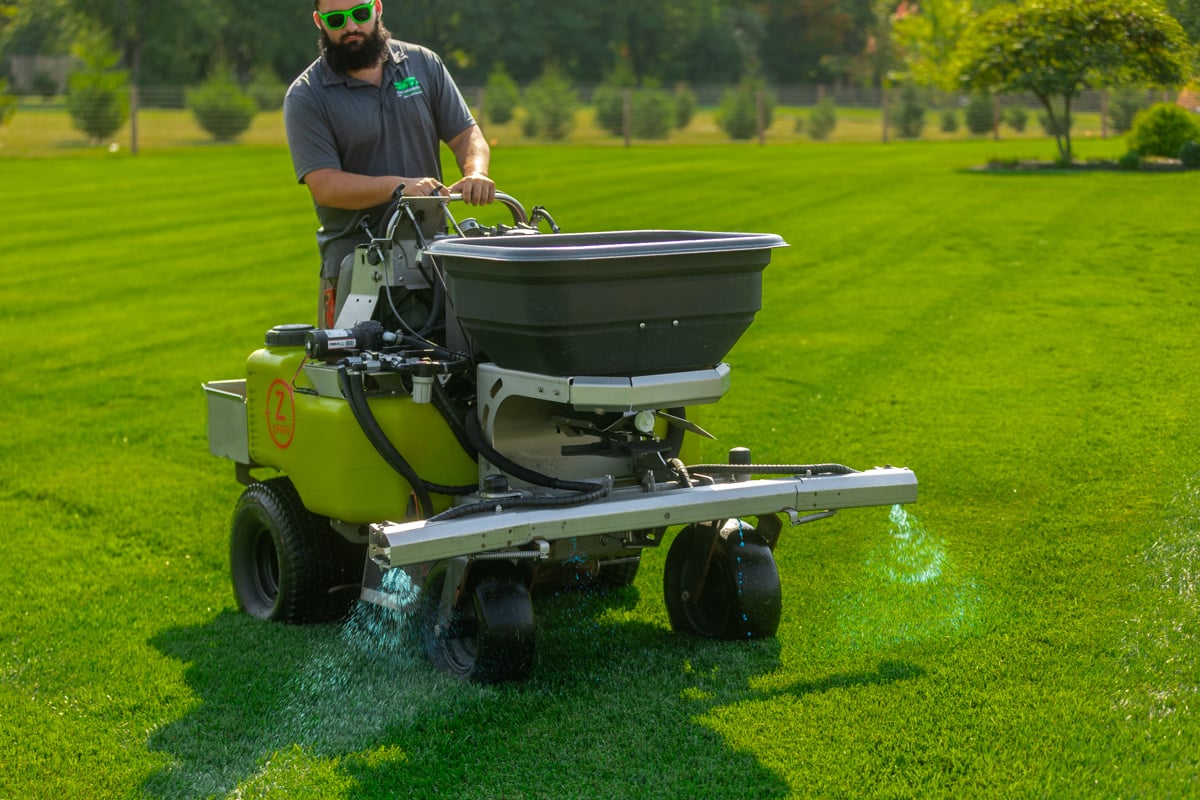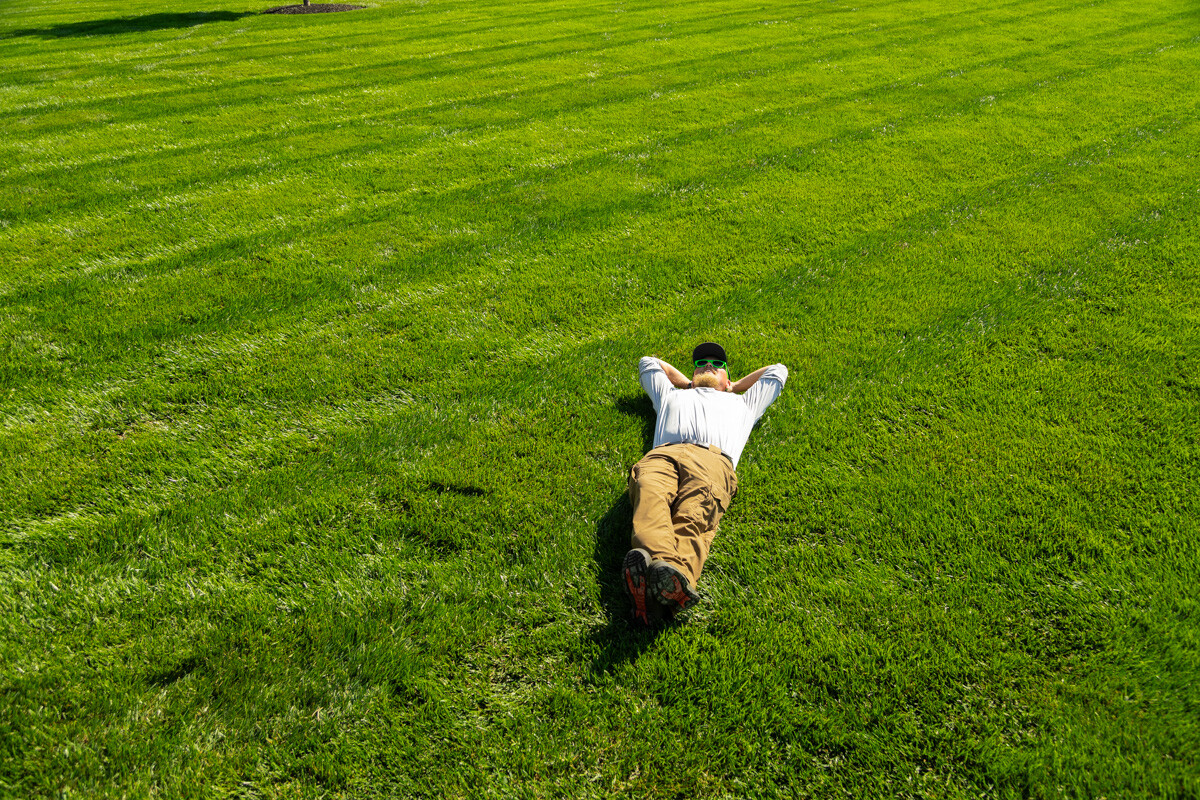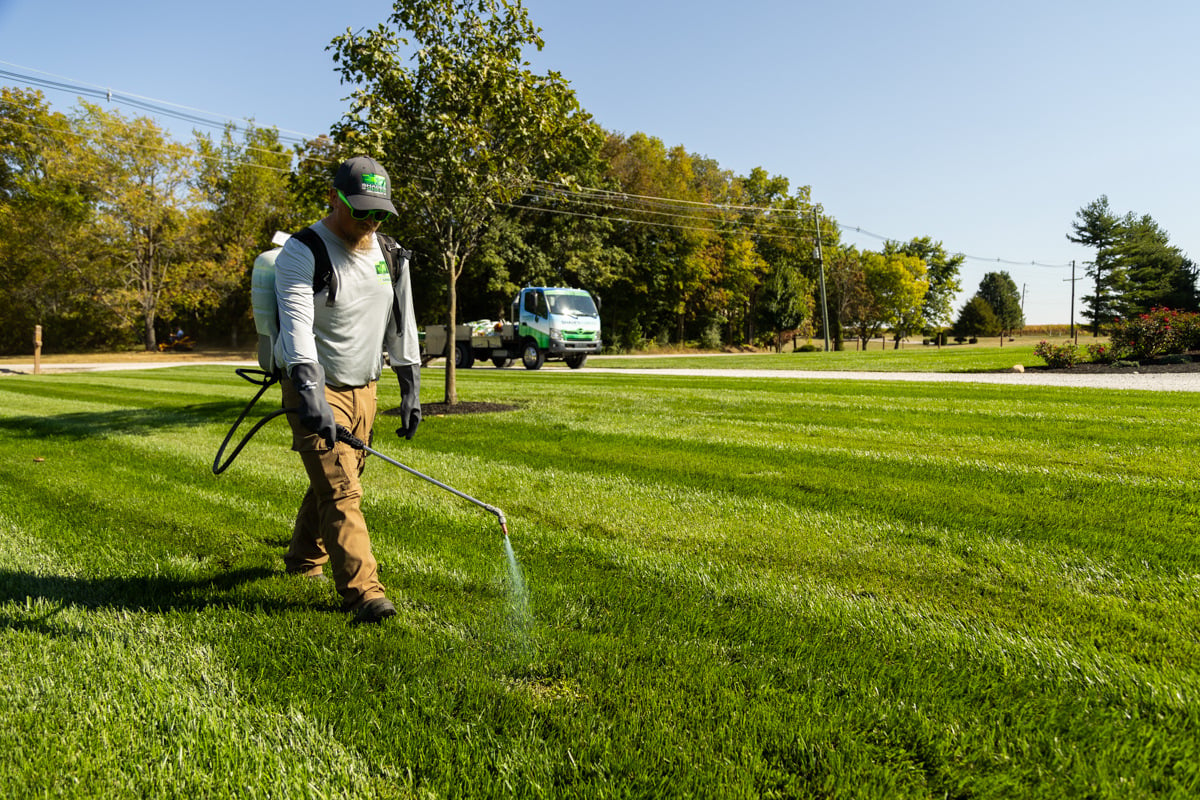



Have you ever found yourself staring at your lawn, wondering when exactly you should be treating it? You are not alone.
Between figuring out what to do and when, and dealing with unpredictable weather, it’s easy to feel overwhelmed. But here’s the good news: maintaining a great lawn doesn’t have to be complicated. With a solid lawn care schedule tailored to Indiana’s unique climate, you can make your yard thrive all year long.
By sticking to a consistent schedule, you’ll ensure your grass gets the right treatments at the right time, setting it up for strong growth, fewer weeds, and less stress. Think of it as a fitness plan for your lawn – just like regular exercise keeps you in shape, a well-timed lawn care routine keeps your grass healthy and lush.
In this guide, we’ll break down how to create a custom Indiana lawn care schedule that delivers results. From spring’s first wakeup call to fall’s recovery phase, we’ve got you covered with month-by-month tips to help your lawn shine. This guide reflects the same science-backed approach we use every day at Shades of Green to care for lawns in Indiana – so you can feel confident you’re following expert advice.
Understanding Climate, Soil, and Grass Types
Why a Custom Indiana Lawn Care Schedule Matters
Your Indiana Lawn Care Calendar
Common Lawn Care Problems
The Pros and Cons of Hiring a Lawn Care Service
FAQ About Lawn Care in Indiana
How to Choose a Lawn Care Professional
If you’ve lived in Indiana for more than five minutes, you already know – the weather here has commitment issues. One day it is sunny and 75 degrees, and the next you’re scraping ice off your windshield. This unpredictable climate makes Indiana lawn care a little tricky and that’s why a solid game plan is key. Indiana’s year-round lawn care isn’t a set-it-and-forget-it situation. It’s all about timing treatments around the weather so your lawn gets what it needs exactly when it needs it.
With all these mood swings, only the toughest grass varieties survive in Indiana. That’s why we stick with cool-season turf grasses, which thrive in our hot summers and can handle the cold winters. The best types of grass in Indiana include:
The ground beneath your feet plays a big role in how your lawn behaves. Clay soil tends to hold on to water like a sponge, which is great – until your lawn turns into a swamp. It also compacts easily, so aeration is a must. Sandy soils drain quickly, which means nutrients are washed away quicker, and it needs extra fertilization and organic matter to keep it happy.
We all love that moment in spring when our lawn shakes off its winter blues and starts turning green again. But if you’re only thinking about lawn care when the grass wakes up, you’re already behind. A lush, healthy lawn isn’t something you wish into existence – it takes a solid lawn application schedule.
A custom lawn care schedule for Indiana isn’t just about throwing down some fertilizer and hoping for the best. It’s about consistency. Skipping months or waiting until there’s a problem is like waiting until you’re starving to meal prep – it’s already too late.
With year-round lawn care in Indiana, you’re giving your grass exactly what it needs, when it needs it. That means:
Month-by-month lawn care in Indiana ensures your yard is always getting the right treatments at the right time. No more guessing, no more scrambling – just a game plan for a thriving lawn, season after season.
 Now that we’ve covered why a lawn care calendar for Indiana matters and how Indiana’s wild weather, tricky soil, and tough turf grasses play a role, let’s get into the good stuff – your month-by-month breakdown of exactly what your lawn needs and when. It’s important to note that the information we review below is representative and may vary each year depending on factors such as weather, seasonal conditions, and when applications begin.
Now that we’ve covered why a lawn care calendar for Indiana matters and how Indiana’s wild weather, tricky soil, and tough turf grasses play a role, let’s get into the good stuff – your month-by-month breakdown of exactly what your lawn needs and when. It’s important to note that the information we review below is representative and may vary each year depending on factors such as weather, seasonal conditions, and when applications begin.
Remember, timing is important. A little proactive care at the right moments can mean the difference between a lawn that turns heads and one that makes you want to keep the blinds closed. At Shades of Green, we spread out our applications by about 4-6 weeks - keep that in mind as you read the information below. So grab your calendar (or just let us do the planning), and let’s map out the best year-round lawn care in Indiana for a healthy, green lawn in every season.
 If you are like everyone else in Indiana, spring is the season when we all remember, “Hey – maybe I should get my lawn in shape this season”. The snow melts, the grass starts waking up, and people rush outside, ready to turn their yard into a golf course overnight. But here’s the truth: spring isn’t the most important lawn care season. Sure, it’s an exciting time, but real lawn success comes from consistent care, not just a flurry of springtime effort.
If you are like everyone else in Indiana, spring is the season when we all remember, “Hey – maybe I should get my lawn in shape this season”. The snow melts, the grass starts waking up, and people rush outside, ready to turn their yard into a golf course overnight. But here’s the truth: spring isn’t the most important lawn care season. Sure, it’s an exciting time, but real lawn success comes from consistent care, not just a flurry of springtime effort.
That said, spring does set the tone for the rest of the growing season. Get it right, and your lawn will be stronger heading into the stressful summer months. Get it wrong, and you’ll be left battling weeds, weak grass, and patchy spots all season. Let’s break down exactly what your lawn needs each month in spring.
Indiana weather in March is unpredictable – one day it’s warm, the next there’s a surprise snowstorm. But as temperatures creep up, your lawn is slowly coming out of dormancy and coming back to life. Start thinking about these lawn care tasks.
Take a walk around and assess damage from winter. Look for snow mold, dead spots, or compacted soil.
If the weather has warmed enough and weeds are making an appearance, start tackling them with spot treatment.
It’s not growing yet, but that’s the point. To stop crabgrass before it sprouts, a pre-emergent herbicide should be applied before soil temperatures hit 55 degrees (usually in late March to early April).
If you want to get serious, test your soil to see if you need any adjustments to pH or nutrients.
April is the time when things usually start moving more quickly. The grass is officially growing, weeds are getting aggressive, and it’s time to take action.
If you missed it in March, now is the time – before it is too late!
Your lawn is waking up hungry. A balanced, slow-release fertilizer will help feed the grass and keep weeds in check.
Proactively treating your lawn for insects like grubs and armyworms can prevent these pests from emerging all season and save you a lot of hassle in the long run.
Start mowing, but don’t go too short. Stick to about 3 inches to keep grass healthy.
With warming temperatures and extra moisture from our spring rains, fungal diseases like red thread and dollar spot can start to pop up.
While you can seed in the spring (and most people want to), fall is a much better time. Oftentimes, if you use a pre-emergent product in spring to combat early weeds any seed you throw down won’t come up anyway.
As temperatures climb, May is all about setting your lawn up for summer survival. Learn when to treat your lawn in May:
Depending on the weather, your lawn may be ready for a second and even third feeding that targets weeds and prepares your lawn for the hot temperatures and stress.
By now, some weeds may have slipped through. Use a post-emergent herbicide to treat them.
If your lawn is struggling, it may be wise to aerate before the summer. Typically, we recommend aeration in the fall - however liquid aeration applications can be great for the spring.
Keep up with mowing, but try to never remove more than ⅓ of the grass blade at a time to avoid stressing out your lawn.
Grubs and other lawn pests are likely becoming active if you didn't use a preventative treatment – keep an eye out for damaged or thinning areas.
 Summer lawn care is all about consistency, not overdoing it. Unlike spring and fall, where we focus on growth and recovery, summer is the season to maintain, monitor, and prevent problems before they get out of hand.
Summer lawn care is all about consistency, not overdoing it. Unlike spring and fall, where we focus on growth and recovery, summer is the season to maintain, monitor, and prevent problems before they get out of hand.
This isn’t the time to push your lawn into overdrive with heavy fertilization or aggressive treatments. Instead, focus on smart mowing, proper watering, and keeping pests and weeds in check so your grass stays strong throughout the heat.
By now, your lawn is in full swing, but summer stress is right around the corner. June is about fortifying your lawn before the real heat kicks in.
Early June is a great time for your next round of slow-release fertilizer, especially if it was especially rainy or slow to warm up in the spring.
Keep your grass 3-4 inches high to provide shade for the soil and retain moisture. Mulch your clippings back into your turf for extra nutrients.
Summer weeds like clover and nutsedge love the heat. Spot-treat problem areas before they spread.
June is prime time for grubs and other lawn pests. Your lawn may start to show signs of damage from grass-eating insects. It's best to prevent this with an early-season treatment.
Lawns need about 1-1 ½ inches of water per week. If rain isn’t cutting it, water deeply in the early morning hours - but infrequently - to encourage deep roots.
The hottest month of the year is about survival. This isn’t the time to stress your lawn out with tons of fertilizer, lots of mowing, or overwatering.
This should be applied in early July and is best to combine with weed control. Don’t overdo it with the nitrogen, as it can burn the grass more easily in the summer heat.
If your lawn turns gray/brown, wilts, or doesn’t bounce back well after stepping on it, it’s thirsty.
If your grass is growing slowly due to heat, mow less frequently. Remember to never cut more than ⅓ of the blade at a time.
Summer annual weeds will continue to pop up at this time.

Brown patch and dollar spot thrive in humid conditions. Talk with a professional if you notice patches of discolored grass, as it may not always be a disease.
August is when lawn care pros start thinking ahead to fall. The cooler months are when your lawn rebounds, so the goal in August is maintenance and preparation.
Continue mowing at 3-4 inches to protect your grass from heat stress.
If summer has been rough, you might see some thin or patchy areas – make a note to overseed in the fall.
Late summer weeds and untreated grubs can still cause trouble. Stay proactive with treatments as needed to prevent further damage from lawn insects.
If your lawn is compacted or struggling, aeration from now through early fall can work wonders – start planning now and be sure to include overseeding to fill in bare spots and build a healthier lawn.
 Fall is the most important season for lawn care in Indiana. While spring gets all the attention, fall is when your lawn truly recovers, strengthens, and prepares for winter. This is the busiest time of year for lawn care because the work you put in now determines how your lawn will look in the spring.
Fall is the most important season for lawn care in Indiana. While spring gets all the attention, fall is when your lawn truly recovers, strengthens, and prepares for winter. This is the busiest time of year for lawn care because the work you put in now determines how your lawn will look in the spring.
Why is fall so crucial?
After summer stress, your lawn is ready to bounce back. This is the best time to aerate lawn in Indiana, as well as a great time to overseed and fertilize to ensure healthy, thick turf.
If your lawn is thin or has bare patches, aerate to loosen compacted soil and overseed to establish new grass before winter. Be sure to prepare ahead of time and provide proper care after your service!
A balanced fertilizer in early September helps with immediate recovery and promotes root growth.
Fall weed control is incredibly effective – plants are pulling in nutrients for winter, which means they absorb herbicides better. Esther-based herbicides work best in cooler fall temperatures.
Now that recovery is underway, October is about reinforcing your lawn’s health before winter.
If you missed the first round, you can still apply herbicides – just keep in mind that results aren’t as visible in the fall. Blanket weed control treatments are ideal, as it is the best time to fight the toughest weeds. The real benefit comes in spring when weeds fail to return.
If your lawn has struggled this year, consider testing your soil to see if pH or nutrient levels need adjustment.
Start removing fallen leaves from your grass regularly. If they pile up, they can smother your grass and welcome pests and disease.
Mulching small amounts of leaves back into the lawn when you mow can help provide additional nutrients to the soil as it decomposes over time.
This month is the final push before winter sets in. Your lawn is still growing underground, and the right care now ensures it emerges strong and green in the spring.
The final fertilizer application is the most important. This heavy-hitter formula prepares your lawn for dormancy, storing nutrients for early growth.
If weeds are present because they weren’t treated earlier in the fall, late-season herbicide applications can be effective. Just ensure weeds are actively growing for best results.
Leaving thick layers of leaves on the lawn can cause snow mold and other fungal diseases – clear them out before snow arrives.
If weeds have been an issue, consider a fall pre-emergent. It settles into the soil over winter and helps prevent weeds in early spring.
 Winter might seem like a time to forget about lawn care, but how you handle dormancy can impact how well your grass bounces back in the spring. While there is not much work to be done, a little monitoring and planning go a long way.
Winter might seem like a time to forget about lawn care, but how you handle dormancy can impact how well your grass bounces back in the spring. While there is not much work to be done, a little monitoring and planning go a long way.
Watch for snow mold, ice damage, and rodent damage. Remember to minimize foot traffic as snow-covered or frozen grass is especially brittle and prone to damage.
Evaluate what did and didn’t work last year. As temperatures begin to fluctuate, take note of any potential issues. Get your mower blades sharpened and calibrate your spreader so you are ready to go when spring arrives.
Hang tight - with the right plan and preparation you'll be enjoying that lush green grass again in no time!
Taking care of your lawn is already a big job, but when unexpected problems pop up, it can feel downright frustrating. Even the most well-maintained lawns can develop weeds, pests, or diseases, and diagnosing the issue isn’t always easy, even for some pros. Sometimes what looks like one problem is a combination of issues affecting your lawn’s health.
The good news? With the right approach, many common lawn problems can be managed or even prevented.
Weeds are persistent and aggressive, stealing nutrients, water, and space from your grass. Some thrive in wet conditions, while others prefer dry, compacted soil – but no matter the type, they’re a nuisance.
Here are some of the common lawn weeds in Indiana:
Want to learn more? We’ve written an entire article about common lawn weeds and weed control in Indiana. Check it out here.
Beyond weeds, lawns in Indiana can suffer from destructive pests and fungal diseases, especially during the hot and humid months.
Here are some common lawn diseases in Indiana:
 Here are some common lawn pests found in Indiana to watch out for:
Here are some common lawn pests found in Indiana to watch out for:
Want to dive deeper? We’ve written blogs about common lawn diseases and common lawn pests, covering how to spot, prevent, and treat them.
Thinking about tackling your own lawn care? It might seem like a budget-friendly idea – until you’re knee-deep in expensive products, time-consuming research, and frustrating trial-and-error. DIY lawn care can quickly turn into an expensive guessing game, with hidden costs like buying all the right tools, fixing mistakes, and spending hours trying to get it right.
At Shades of Green, we take the hassle out of lawn care by providing expert treatments tailored to your lawn. Our team knows exactly what Indiana lawns need – no guesswork or wasted time. Plus, we use professional-grade products and equipment that aren’t available at your local hardware store. If you’re someone who takes satisfaction in taking care of all the yard work yourself, then hiring a lawn care professional may not be the right fit for you.
For as little as $41 per month, our Standard Plan covers everything your lawn needs, including fertilizer, weed control, grub treatments, micronutrients, pH adjustments, and free service calls. No extra trips to the store, no wasted weekends, just a healthy, vibrant lawn without the stress. There can be big price differences between different companies, so it’s important to judge a lawn service by its results rather than the price tag. To learn more about how much lawn care costs, check out this blog where we dove deeper into the true costs of lawn care.
We know sometimes you just want a quick answer to lawn care questions so you can get to work. Let’s answer a few of our most popular lawn care questions:

Choosing a lawn care service can feel like navigating a maze of promises, flashy ads, and fine print. Every company claims they are the best, but how do you separate the real pros from those just looking to make a quick buck? The key is knowing what to look for – because when it comes to your lawn, you deserve more than just the basics.
Start by looking at reputation. Reviews and testimonials can tell you a lot about a company’s reliability and results. Happy customers leave clues – glowing Google reviews, positive social media mentions, and before-and-after photos that show real progress. If a company has a solid track record of satisfied customers, that’s a strong sign they’ll take good care of your lawn, too.
Next, consider knowledge and expertise. Years in business are important, but so is a commitment to ongoing education. In Indiana, where lawn care is impacted by unpredictable weather and unique soil conditions, a company that invests in training and stays up-to-date on turf science is worth your time. Look for one that uses high-quality, customized products instead of generic treatments.
Transparent pricing is another big factor. A reputable company will be upfront about costs and provide clear service plans so you know exactly what you’re getting. Beware of the lowest price – sometimes, it means cutting corners and lower-quality treatments. Instead, look for a company that balances fair pricing with top-tier service.
Finally, assess their customer service. Do they answer questions? Adjust treatments based on weather conditions? Offer expert recommendations? The best lawn care providers don’t just show up, apply a treatment, and leave. They partner with you to create a lawn care plan that truly fits your yard’s needs.
At the end of the day, choosing the right lawn care company is about trust. You want a team that treats your lawn like their own – one that invests in quality, prioritizes your lawn’s health, and stands by their results.
At Shades of Green, we understand how important your lawn is to you, whether it’s a place for family gatherings, relaxation, or simply a beautiful view. We’re here to help you by offering personalized lawn care that fits your lawn’s unique needs.
We know that managing a lawn can feel overwhelming at times, but you don’t have to do it alone. If you’re ready for a lawn care schedule that works for you, we’d love to be a part of your journey.
Ready to implement a lawn care schedule that delivers results for your Indiana home in Lafayette, Carmel, Westfield, or Noblesville? Get started today by filling out our contact form.
Images Sources: red thread lawn disease, bluegrass billbug

Cory is the heart and soul of Shades of Green. His dedication to doing right for our customers has been the driving force behind the company's success. With a degree in Turf Science from Purdue University, Cory continually strives to craft the best treatment plans using the latest technologies and innovative products, ensuring top-notch results for every client.





